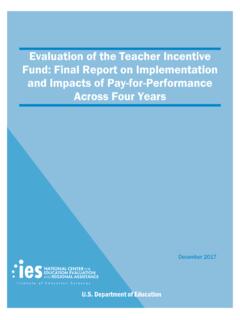Transcription of Using Student Achievement Data to Support Instructional ...
1 Using Student Achievement Data to Support Instructional Decision MakingUsing Student Achievement Data to Support Instructional Decision MakingNCEE DEPARTMENT OF EDUCATIONIES PRACTICE GUIDEWHAT WORKS CLEARINGHOUSEThe Institute of Education Sciences (IES) publishes practice guides in education to bring the best available evidence and expertise to bear on the types of challenges that cannot currently be addressed by a single intervention or program. Authors of practice guides seldom conduct the types of systematic literature searches that are the backbone of a meta-analysis, although they take advantage of such work when it is already published.
2 Instead, authors use their expertise to identify the most im-portant research with respect to their recommendations and conduct a search of recent publications to ensure that the research supporting the recommendations is up-to-date. Unique to IES-sponsored practice guides is that they are subjected to rigorous exter-nal peer review through the same office that is responsible for independent reviews of other IES publications. A critical task for peer reviewers of a practice guide is to determine whether the evidence cited in Support of particular recommendations is up-to-date and that studies of similar or better quality that point in a different di-rection have not been ignored.
3 Because practice guides depend on the expertise of their authors and their group decision making, the content of a practice guide is not and should not be viewed as a set of recommendations that in every case depends on and flows inevitably from scientific goal of this practice guide is to formulate specific and coherent evidence-based recommendations for use by educators and education administrators to create the organizational conditions necessary to make decisions Using Student Achievement data in classrooms, schools, and districts.
4 The guide provides practical, clear in-formation on critical topics related to data-based decision making and is based on the best available evidence as judged by the panel. Recommendations presented in this guide should not be construed to imply that no further research is warranted on the effectiveness of particular strategies for data-based decision Student Achievement Data to Support Instructional Decision MakingSeptember 2009 PanelLaura Hamilton (Chair)RAND CoRpoRAtioNRichard HalversonUNiveRsity of WisCoNsiN MADisoNSharnell S.
5 JacksonChiCAgo pUbliC sChools Ellen MandinachCNA eDUCAtioNJonathan A. SupovitzUNiveRsity of peNNsylvANiAJeffrey C. Waymanthe UNiveRsity of texAs At AUstiNStaffCassandra PickensEmily Sama MartinMAtheMAtiCA poliCy ReseARChJennifer L. SteeleRAND CoRpoRAtioNNCEE DEPARTMENT OF EDUCATIONIES PRACTICE GUIDEThis report was prepared for the National Center for Education Evaluation and Re-gional Assistance, Institute of Education Sciences, under Contract ED-07-CO-0062 by the What Works Clearinghouse, operated by Mathematica Policy The opinions and positions expressed in this practice guide are the authors and do not necessarily represent the opinions and positions of the Institute of Education Sci-ences or the Department of Education.
6 This practice guide should be reviewed and applied according to the specific needs of the educators and education agency Using it, and with the full realization that it represents the judgments of the review panel regarding what constitutes sensible practice, based on the research available at the time of publication. This practice guide should be used as a tool to assist in decision making rather than as a cookbook. Any references within the document to specific education products are illustrative and do not imply endorsement of these products to the exclusion of other products that are not referenced.
7 Department of Education Arne Duncan Secretary Institute of Education Sciences John Q. EastonDirector National Center for Education Evaluation and Regional Assistance John Q. EastonActing Commissioner September 2009 This report is in the public domain. While permission to reprint this publication is not necessary, the citation should be: Hamilton, L., Halverson, R., Jackson, S., Mandinach, E., Supovitz, J., & Wayman, J. (2009). Using Student Achievement data to Support Instructional decision making (NCEE 2009-4067).
8 Washington, DC: National Center for Education Evaluation and Regional Assistance, Institute of Education Sciences, Department of Education. Retrieved from What Works Clearinghouse Practice Guide citations begin with the panel chair, followed by the names of the panelists listed in alphabetical report is available on the IES website at and Alternative formats On request, this publication can be made available in alternative formats, such as Braille, large print, audiotape, or computer diskette. For more information, call the Alternative Format Center at 202 205 8113.
9 ( iii ) Using Student Achievement Data to Support Instructional Decision MakingContentsIntroduction 1 The What Works Clearinghouse standards and their relevance to this guide 4 Overview 5 Scope of the practice guide 6 Status of the research 6 Summary of the recommendations 7 Checklist for carrying out the recommendations 9 Recommendation 1. Make data part of an ongoing cycle of Instructional improvement 10 Recommendation 2. Teach students to examine their own data and set learning goals 19 Recommendation 3. Establish a clear vision for schoolwide data use 27 Recommendation 4.
10 Provide supports that foster a data-driven culture within the school 33 Recommendation 5. Develop and maintain a districtwide data system 39 Glossary of terms as used in this report 46 Appendix A. Postscript from the Institute of Education Sciences 49 Appendix B. About the authors 52 Appendix C. Disclosure of potential conflicts of interest 54 Appendix D. Technical information on the studies 55 References 66( iv ) Using Student Achievement DATA TO Support Instructional DECISION MAKINGList of tablesTable 1. Institute of Education Sciences levels of evidence for practice guides 3 Table 2.









